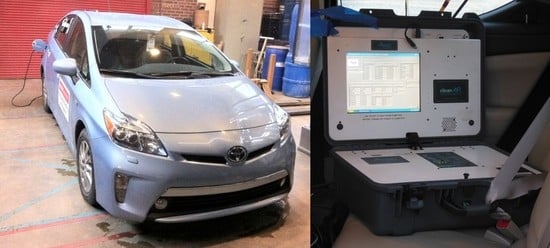Variability in Measured Real-World Operational Energy Use and Emission Rates of a Plug-In Hybrid Electric Vehicle
Abstract
1. Introduction
2. Materials and Methods
2.1. Field Study Design
2.2. Instruments
2.3. Upstream Energy Use and Emissions for Gasoline Production
2.4. Indirect Energy Use and Emissions for Electricity Generation
2.5. Data Synchronization and Quality Assurance
2.6. Charge Depleting (CD) and Charge Sustaining (CS) Modes
2.7. Power Demand–Vehicle Specific Power (VSP)
2.8. Engine On and Engine Off
2.9. Cold Start and Hot Stabilized Operation
2.10. Comparison with Conventional Light Duty Gasoline Vehicles
3. Results
3.1. Quality Assurance
3.2. Charge Depleting (CD) and Charge Sustaining (CS) Modes
3.3. Cold Start and Hot Stabilized Operation
4. Discussion
5. Conclusions
Supplementary Materials
Author Contributions
Funding
Acknowledgments
Conflicts of Interest
References
- Millo, F.; Rolando, L.; Fuso, R. Real world operation of a complex plug-in hybrid electric vehicle: Analysis of its CO2 emissions and operating costs. Energies 2014, 7, 4554–4570. [Google Scholar] [CrossRef]
- Chen, Y.; Hu, K.; Zhao, J.; Li, G.; Johnson, J.; Zietsman, J. In-use energy and CO2 emissions impact of a plug-in hybrid and battery electric vehicle based on real-world driving. Int. J. Environ. Sci. Technol. 2018, 15, 1001–1008. [Google Scholar] [CrossRef]
- Lane, B.W.; Dumortier, J.; Carley, S.; Siddiki, S.; Clark-Sutton, K.; Graham, J.D. All plug-in electric vehicles are not the same: Predictors of preference for a plug-in hybrid versus a battery-electric vehicle. Transp. Res. Part D 2018, 65, 1–13. [Google Scholar] [CrossRef]
- Williams, B.; Martin, E.; Lipman, T.; Dammen, D. Plug-in-hybrid vehicle use, energy consumption, and greenhouse emissions: An analysis of household vehicle placements in Northern California. Energies 2011, 4, 435–457. [Google Scholar] [CrossRef]
- Plotz, P.; Funke, S.A.; Jochen, P. Empirical fuel consumption and CO2 emissions of plug-in hybrid electric vehicles. J. Ind. Ecol. 2017, 22, 773–784. [Google Scholar] [CrossRef]
- Alliance of Automobile Manufacturers (2019), Advanced Technology Vehicle Sales Dashboard. Available online: https://autoalliance.org/energy-environment/advanced-technology-vehicle-sales-dashboard/ (accessed on 16 February 2020).
- Kane, M. Global Sales December & 2018: 2 Million Plug-In Electric Cars Sold. Available online: https://insideevs.com/news/342547/global-sales-december-2018–2-million-plug-in-electric-cars-sold/ (accessed on 16 February 2020).
- EVAdoption, Available PHEVs (In the US): Currently Available Plug-in Hybrid EVs (PHEVs)—US (As of January 3. Available online: https://evadoption.com/ev-models/available-phevs/ (accessed on 16 February 2020).
- Mansour, C.; Haddad, M.; Zgheib, E. Assessing consumption, emissions and costs of electrified vehicles under real driving conditions in a developing country with an inadequate road transport system. Transp. Res. Part D 2018, 63, 498–513. [Google Scholar] [CrossRef]
- Zhou, B.; Zhang, S.; Wu, Y.; Ke, W.; He, X.; Hao, J. Energy-saving benefits from plug-in hybrid electric vehicles: Perspectives based on real-world measurements. Mitig. Adapt. Strateg. Glob. Chang. 2018, 23, 735–756. [Google Scholar] [CrossRef]
- Graver, B.M.; Frey, H.C.; Choi, H.W. In-use measurement of activity, energy use, and emissions of a plug-in hybrid electric vehicle. Environ. Sci. Technol. 2011, 45, 9044–9051. [Google Scholar] [CrossRef]
- Chambon, P.; Deter, D.; Irick, D.; Smith, D. PHEV Cold Start Emissions Management. SAE Intern. J. Altern. Powertrains 2013, 2, 252–260. [Google Scholar] [CrossRef]
- Hamza, K.; Laberteaux, K. A Study on optimal powertrain Sizing of plugin hybrid vehicles for minimizing criteria emissions associated with cold starts. SAE Intern. J. Altern. Powertrains 2018, 7, 183–193. [Google Scholar] [CrossRef]
- Frey, H.C. Critical Review: Trends in onroad transportation energy and emissions. J. Air Waste Manag. Assoc. 2018, 68, 514–563. [Google Scholar] [CrossRef] [PubMed]
- Karbowski, D.; Rousseau, A.; Pagerit, S.; Sharer, P. Plug-in Vehicle Control Strategy: From Global Optimization to Real Time Application. In Proceedings of the 22nd Electric Vehicle Symposium, Japan Automobile Research Institute, EVS22, Yokohama, Japan, 22–28 October 2006. [Google Scholar]
- Jefferson, C.M.; Barnard, R.H. Hybrid Vehicle Propulsion; WIT Press: Billerica, MA, USA, 2002. [Google Scholar]
- Wirasingha, S.G.; Emadi, A. Classification and review of control strategies for plug-in hybrid electric vehicles. IEEE Trans. Veh. Technol. 2001, 60, 111–122. [Google Scholar] [CrossRef]
- Sun, L.; Liang, R.; Wang, Q. The Control Strategy and System Preferences of Plug-in HEV. In Proceedings of the Vehicle Power and Propulsion Conference, IEEE, Hei Longjiang, China, 3–5 September 2008; pp. 1–5. [Google Scholar]
- Thompson, T.; Webber, M.; Allen, D.T. Air quality impacts of using overnight electricity generation to charge plug-in hybrid electric vehicles for daytime use. Environ. Res. Lett. 2009, 4, 014002. [Google Scholar] [CrossRef]
- Hajimiragha, A.H.; Cañizares, C.; Fowler, M.W.; Moazeni, S.; Elkamel, A. A robust optimization approach for planning the transition to plug-in hybrid electric vehicles. IEEE Trans. Power Syst. 2011, 26, 2264–2274. [Google Scholar] [CrossRef]
- Samaras, C.; Meisterling, K. Life cycle assessment of greenhouse gas emissions from plug-in hybrid vehicles: Implications for policy. Environ. Sci. Technol. 2008, 42, 3170–3176. [Google Scholar] [CrossRef] [PubMed]
- Elgowainy, A.; Burnham, A.; Wang, M.; Molburg, J.; Rousseau, A. Well-to-wheels energy use and greenhouse gas emissions of plug-in hybrid electric vehicles. SAE Tech. Pap. 2009, 2, 627–644. [Google Scholar]
- Bradley, T.H.; Frank, A.A. Design, demonstrations and sustainability impact assessments for plug-in hybrid electric vehicles. Renew. Sustain. Energy Rev. 2009, 13, 115–128. [Google Scholar] [CrossRef]
- Shidore, N.; Bohn, T.; Duoba, M.; Lohse-Busch, H.; Sharer, P. PHEV ‘All Electric Range’ and Fuel Economy in Charge Sustaining Mode for Low SOC Operation of The JCS VL41M Li-ion Battery Using Battery HIL. In Proceeding of the Electric Vehicle Symposium, Anaheim, CA, USA, 2–5 December 2007; Volume 23, pp. 2–5. [Google Scholar]
- Jimenez-Palacios, J.L. Understanding and Quantifying Motor Vehicle Emissions with Vehicle Specific Power and TILDAS Remote Sensing. Ph.D. Thesis, Massachusetts Institute of Technology, Cambridge, MA, USA, 1999. [Google Scholar]
- Zhai, H.; Frey, H.C.; Rouphail, N.M. A vehicle-specific power approach to speed-and facility-specific emissions estimates for diesel transit buses. Environ. Sci. Technol. 2008, 42, 7985–7991. [Google Scholar] [CrossRef]
- Frey, H.C.; Unal, A.; Chen, J.; Li, S.; Xuan, C. Methodology for Developing Modal Emission Rates for EPA’s Multi-scale Motor Vehicle & Equipment Emission System; EPA420-R-02–027, Prepared by North Carolina State University; USA Environmental Protection Agency: Ann Arbor, MI, USA, 2002.
- Markey, J. Federal Test Procedure Review Project: Preliminary Technical Report; EPA 420-R-93–007; USA Environmental Protection Agency: Ann Arbor, MI, USA, 1993.
- Weilenmann, M.; Favez, J.Y.; Alvarez, R. Cold-start emissions of modern passenger cars at different low ambient temperatures and their evolution over vehicle legislation categories. Atmos. Environ. 2009, 43, 2419–2429. [Google Scholar] [CrossRef]
- Alvarez, R.; Weilenmann, M. Effect of low ambient temperature on fuel consumption and pollutant and CO2 emissions of hybrid electric vehicles in real-world conditions. Fuel 2012, 97, 119–124. [Google Scholar] [CrossRef]
- Duarte, G.O.; Varella, R.A.; Gonçalves, G.A.; Farias, T.L. Effect of battery state of charge on fuel use and pollutant emissions of a full hybrid electric light duty vehicle. J. Power Sources 2014, 246, 377–386. [Google Scholar] [CrossRef]
- Kum, D.; Peng, H.; Bucknor, N.K. Optimal energy and catalyst temperature management of plug-in hybrid electric vehicles for minimum fuel consumption and tail-pipe emissions. IEEE Trans. Control Syst. Technol. 2013, 21, 14–26. [Google Scholar] [CrossRef]
- Frey, H.C.; Zhang, K.; Rouphail, N.M. Fuel use and emissions comparisons for alternative routes, time of day, road grade, and vehicles based on in-use measurements. Environ. Sci. Technol. 2008, 42, 2483–2489. [Google Scholar] [CrossRef] [PubMed]
- Frey, H.C.; Graver, B.M. Real-world activity, energy use, and emissions of a plug-in hybrid electric vehicle. In Grid Electrified Vehicle: Performance, Design, and Environmental Impact; Nova Science Publishers: New York, NY, USA, 2013; Chapter 9. [Google Scholar]
- OEM-2100AX Axion User’s Manual, Version 2; Clean Air Technologies International, Inc.: Buffalo, NY, USA, 2008.
- Frey, H.C.; Unal, A.; Rouphail, N.M.; Colyar, J.D. On-road measurement of vehicle tailpipe emissions using a portable instrument. J. Air Waste Manag. Assoc. 2003, 53, 992–1002. [Google Scholar] [CrossRef] [PubMed]
- Myers, J.; Kelly, T.; Dindal, A.; Willenberg, Z.; Riggs, K. Environmental Technology Verification Report: Clean Air Technologies International, Inc. REMOTE On-Board Emissions Monitor; USA Environmental Protection Agency: Cincinnati, OH, USA, 2003.
- Boroujeni, B.Y.; Frey, H.C. Road grade quantification based on global positioning system data obtained from real-world vehicle fuel use and emissions measurements. Atmos. Environ. 2014, 85, 179–186. [Google Scholar] [CrossRef]
- Wang, M. GREET 1.5—Transportation Fuel-Cycle Model - Volume 1: Methodology, Development, Use, and Results; Center for Transportation Research, Energy Systems Division, Argonne National Laboratory: Lemont, IL, USA, 1999.
- Hybrid-EV Committee. Recommended Practice for Measuring the Exhaust Emissions and Fuel Economy of Hybrid-Electric Vehicles, Including Plug-in Hybrid Vehicles. In Proceedings of the SAE Std. J1711_SAE World Congress, Detroit, MI, USA, 13–15 April 2010. [Google Scholar]
- USA Environmental Protection Agency. New Fuel Economy and Environment Labels for a New Generation of Vehicles; EPA-420-F-11–017a; Research Triangle Park: Durham, NC, USA, 2011. [Google Scholar]
- USA Environmental Protection Agency. eGRID 9th edition Version 1.0—Summary Tables for year 2010 data. Available online: https://www.epa.gov/energy/egrid-9th-edition-version-10-summary-tables-year-2010-data (accessed on 16 February 2020).
- USA Energy Information Administration. Electricity: Detailed State Data. Available online: http://www.eia.gov/electricity/data/state/ (accessed on 16 February 2020).
- USA Energy Information Administration. Electricity: Form EIA-923 detailed data with previous form data (EIA-906/920). Available online: http://www.eia.gov/electricity/data/eia923/ (accessed on 16 February 2020).
- USA Environmental Protection Agency. 2011 National Emissions Inventory (NEI) Data. Available online: https://www.epa.gov/air-emissions-inventories/2011-national-emissions-inventory-nei-data (accessed on 16 February 2020).
- USA Environmental Protection Agency. State CO2 Emissions from Fossil Fuel Combustion. Available online: https://www.epa.gov/statelocalenergy/state-co2-emissions-fossil-fuel-combustion (accessed on 16 February 2020).
- USA Department of Energy, Lower and Higher Heating Values of Hydrogen and Other Fuels. Available online: https://h2tools.org/hyarc/hydrogen-data/lower-and-higher-heating-values-hydrogen-and-other-fuels (accessed on 16 February 2020).
- International Carbon Bank & Exchange. Volume Calculation of One Ton CO. Available online: http://www.icbe.com/carbondatabase/CO2volumecalculation.asp (accessed on 16 February 2020).
- Andervazh, M.-R.; Javadi, S. Emission-economic dispatch of thermal power generation units in the presence of hybrid electric vehicles and correlated wind power plants. IET Gener. Transm. Distrib. 2017, 11, 2232–2243. [Google Scholar] [CrossRef]
- Sandhu, G.S.; Frey, H.C. Effects of errors on vehicle emission rates from portable emissions measurement systems. Trans. Res. Rec. 2013, 2340, 10–19. [Google Scholar] [CrossRef]
- Frey, H.C.; Zhang, K.; Rouphail, N.M. Vehicle specific emissions modeling based on On-Road measurements. Environ. Sci. Technol. 2010, 44, 3594–3600. [Google Scholar] [CrossRef]
- Liu, B.; Frey, H.C. Variability in light-duty gasoline vehicle emission factors from trip-based real-world measurements. Environ. Sci. Technol. 2015, 49, 12525–12534. [Google Scholar] [CrossRef]
- Zhai, H.; Frey, H.C.; Rouphail, N.M. Development of a modal emissions model for a hybrid electric vehicle. Transp. Res. Part D 2011, 16, 444–450. [Google Scholar] [CrossRef]
- Choi, H.W.; Frey, H.C. Method for in-use measurement and evaluation of the activity, fuel use, electricity use, and emissions of a plug-in hybrid diesel-electric school bus. Environ. Sci. Technol. 2010, 44, 3601–3607. [Google Scholar] [CrossRef] [PubMed]
- McLaren, J.; Miller, J.; O’Shaughnessy, E.; Wood, E.; Shapiro, E. Emissions Associated with Electric Vehicle Charging: Impact of Electricity Generation Mix, Charging Infrastructure Availability, and Vehicle Type; NREL/TP-6A20–64852; National Renewable Energy Laboratory: Golden, CO, USA, April 2016.
- Gadh, R. Demonstrating Plug-in Electric Vehicles Smart Charging and Storage Supporting the Grid; CEC-500–2018–020; UCLA Smart Grid Energy Research Center (SMERC) for California Energy Commission: Sacramento, CA, USA, 2016.
- Timmers, V.R.J.H.; Achten, P.A.J. Non-exhaust pm emissions from electric vehicles. Atmos. Environ. 2016, 10–17. [Google Scholar] [CrossRef]
- Faria, R.; Marques, P.; Moura, P.; Freire, F.; Delgado, J.; de Almeida, A.T. Impact of the electricity mix and use profile in the life-cycle assessment of electric vehicles. Renew. Sustain. Energy Rev. 2013, 24, 271–287. [Google Scholar] [CrossRef]
- Onat, N.C.; Kucukvar, M.; Tatari, O. Well-to-wheel water footprints of conventional versus electric vehicles in the United States: A state-based comparative analysis. J. Clean. Prod. 2018, 204, 788–802. [Google Scholar] [CrossRef]
- Bicer, Y.; Dincer, I. Life cycle environmental impact assessments and comparisons of alternative fuels for clean vehicles. Resour. Conserv. Recycl. 2018, 132, 141–157. [Google Scholar] [CrossRef]
- Onat, N.C.; Kucukvar, M.; Afshar, S. Eco-efficiency of electric vehicles in the United States: A life cycle assessment based principal component analysis. J. Clean. Prod. 2019, 212, 515–526. [Google Scholar] [CrossRef]
- Cusenza, M.A.; Bobba, S.; Ardente, F.; Cellura, M. Energy and environmental assessment of a traction lithium-ion battery pack for plug-in hybrid electric vehicles. J. Clean. Prod. 2019, 215, 634–649. [Google Scholar] [CrossRef]
- Zanchi, L.; Delogu, M.; Ierides, M.; Vasiliadis, H. Life Cycle Assessment and Life Cycle Costing as Supporting Tools for EVs Lightweight Design. In Sustainable Design and Manufacturing SDM Smart Innovation, Systems and Technologies; Setchi, R., Howlett, R., Liu, Y., Theobald, P., Eds.; Springer: Cham, Switzerland, 2016. [Google Scholar]
- Lutsey, N.; Nicholas, M. Update on Electric Vehicle Costs in the United States Through Working Paper 2019. In Proceedings of the International Council on Clean Transportation, Ankara, Turkey, 2 April 2019. [Google Scholar]
- Feng, B.; Ye, Q.; Collins, B.J. A dynamic model of electric vehicle adoption: The role of social commerce in new transportation. Inf. Manag. 2019, 52, 196–212. [Google Scholar] [CrossRef]
- USA Environmental Protection Agency. MOVES2014a User Guide; EPA-420-B-15–095; USA Environmental Protection Agency: Ann Arbor, MI, USA, November 2015.
- Kane, M. PHEV Car Range, Price & More Compared For, USA—July. Available online: https://insideevs.com/news/361183/phev-car-compared-us-july-2019/ (accessed on 24 February 2020).
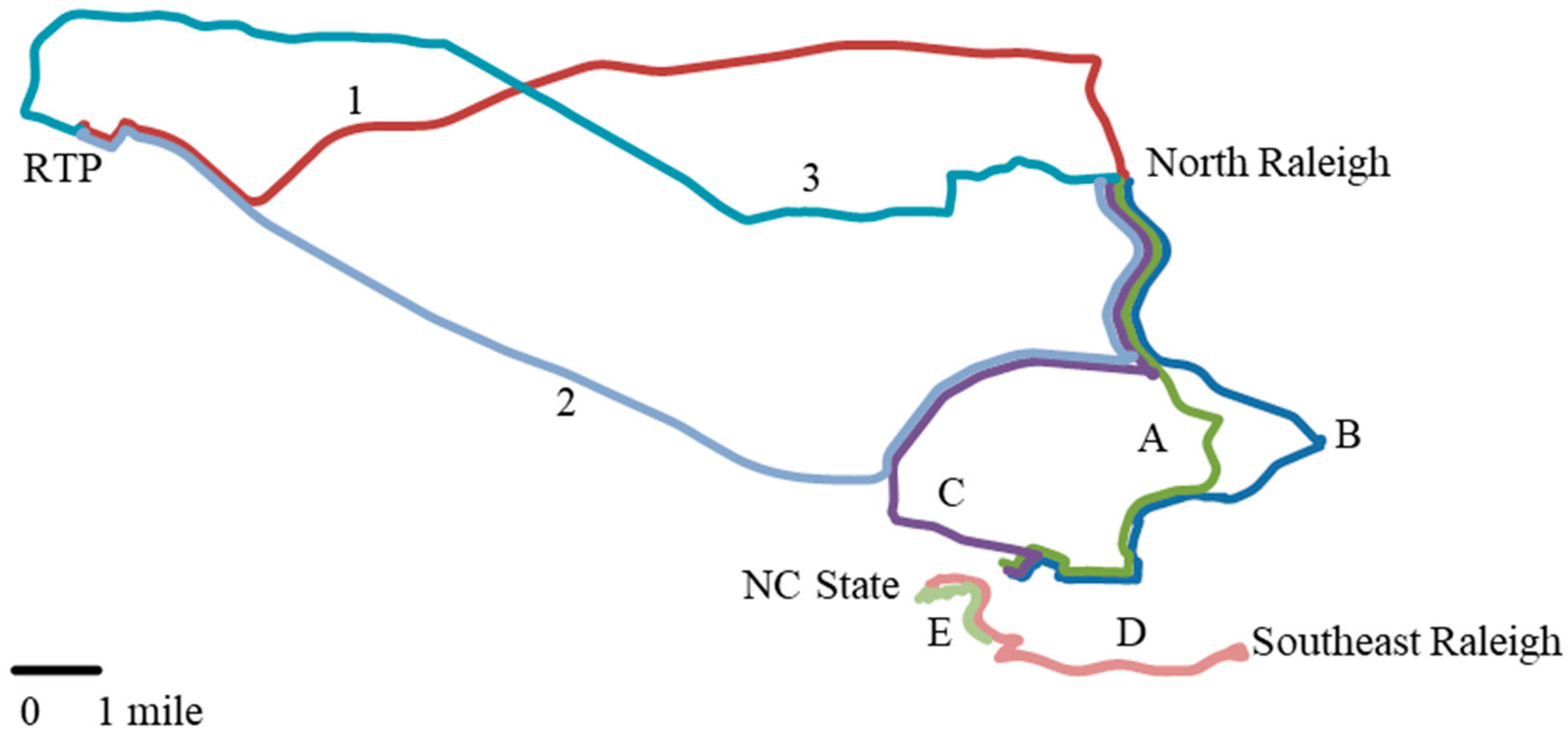
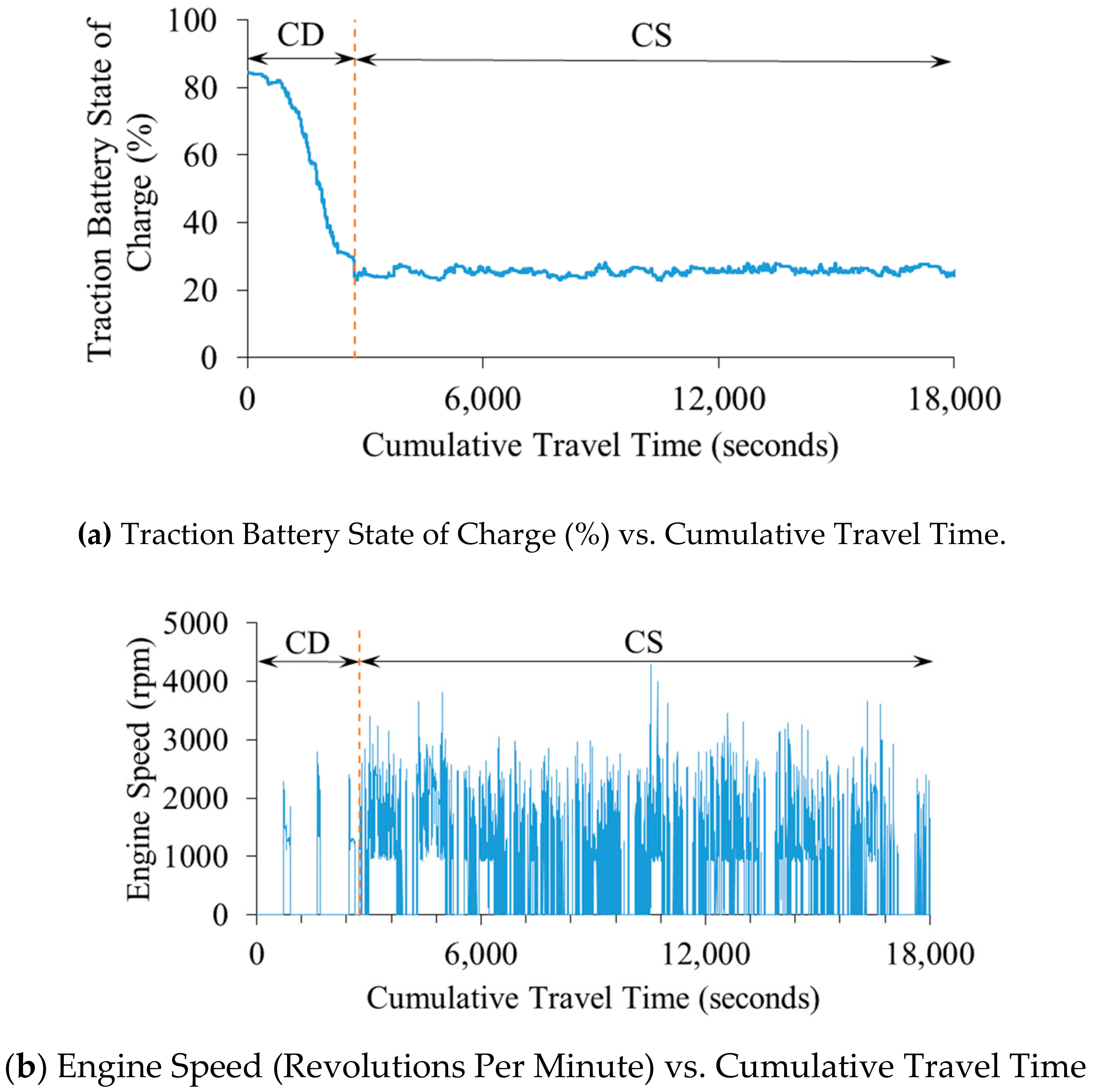

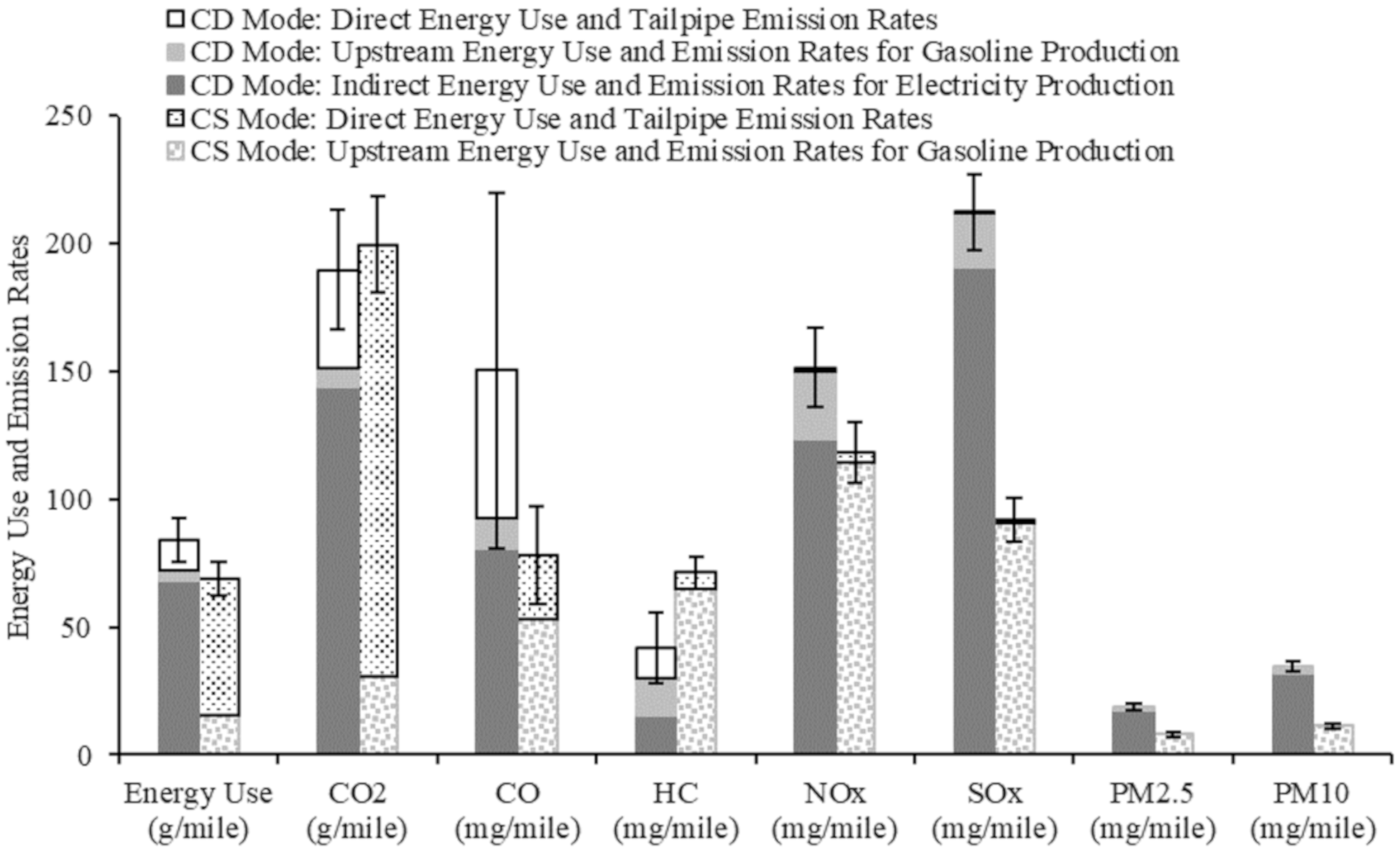
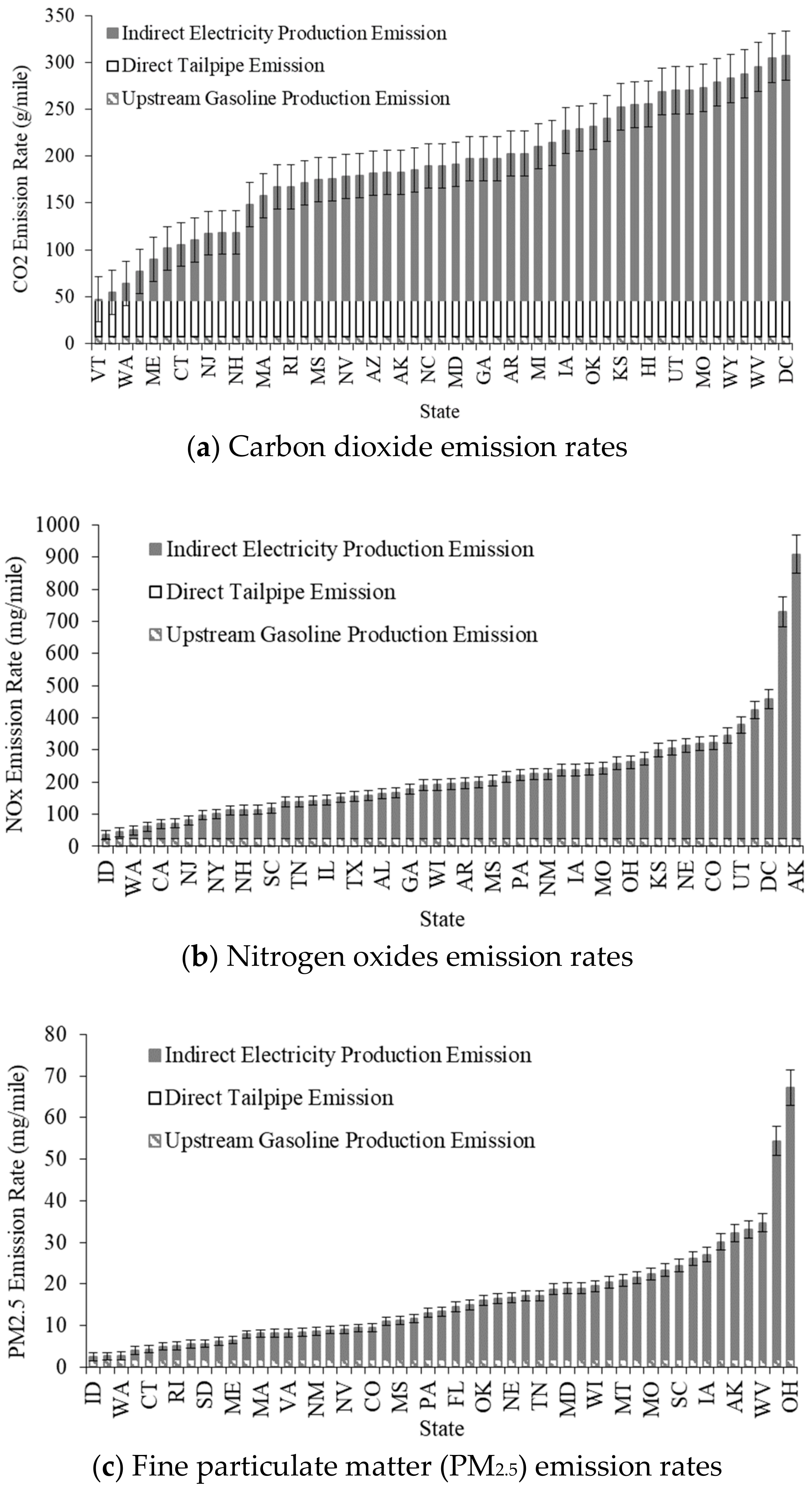

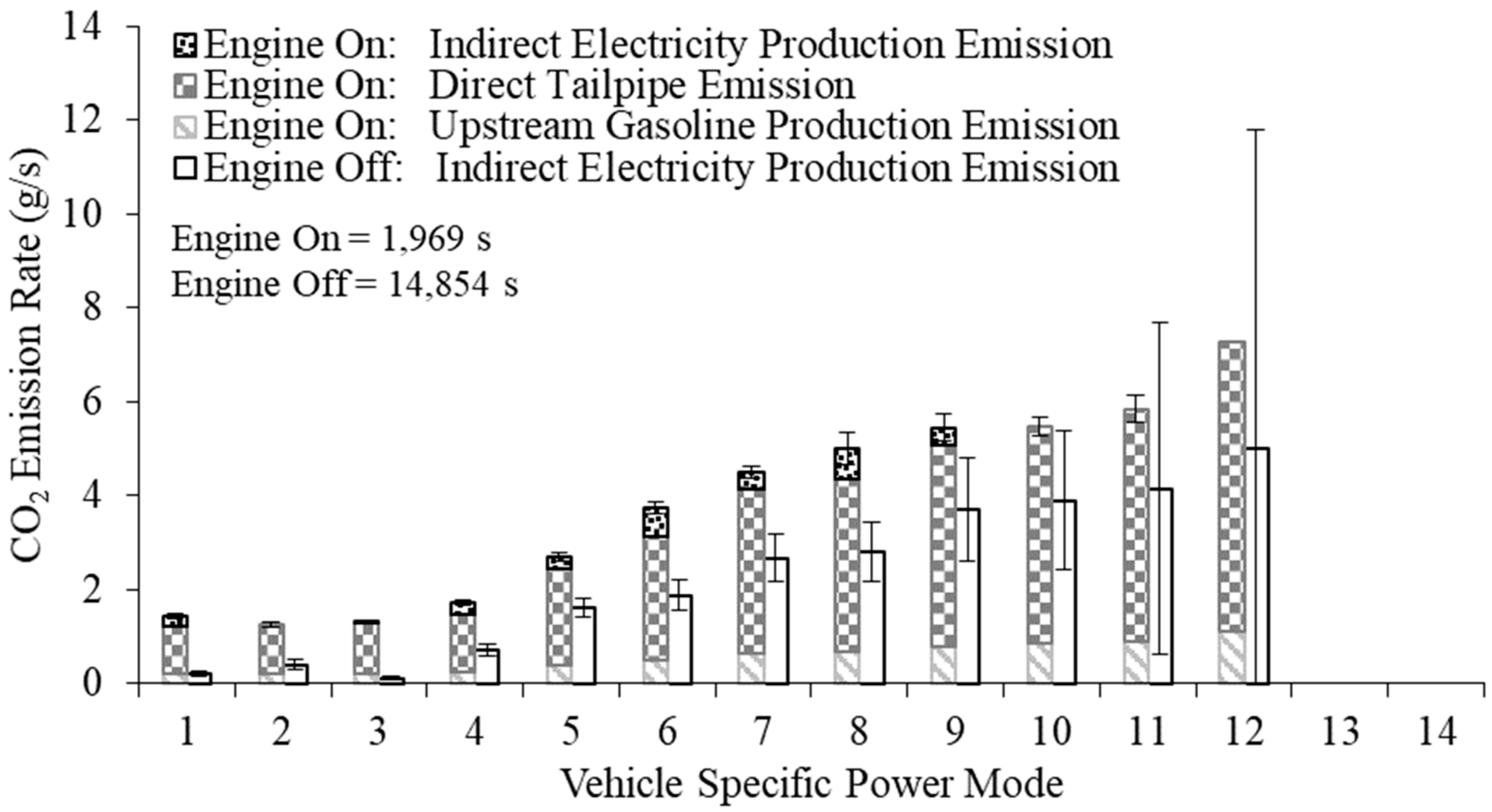

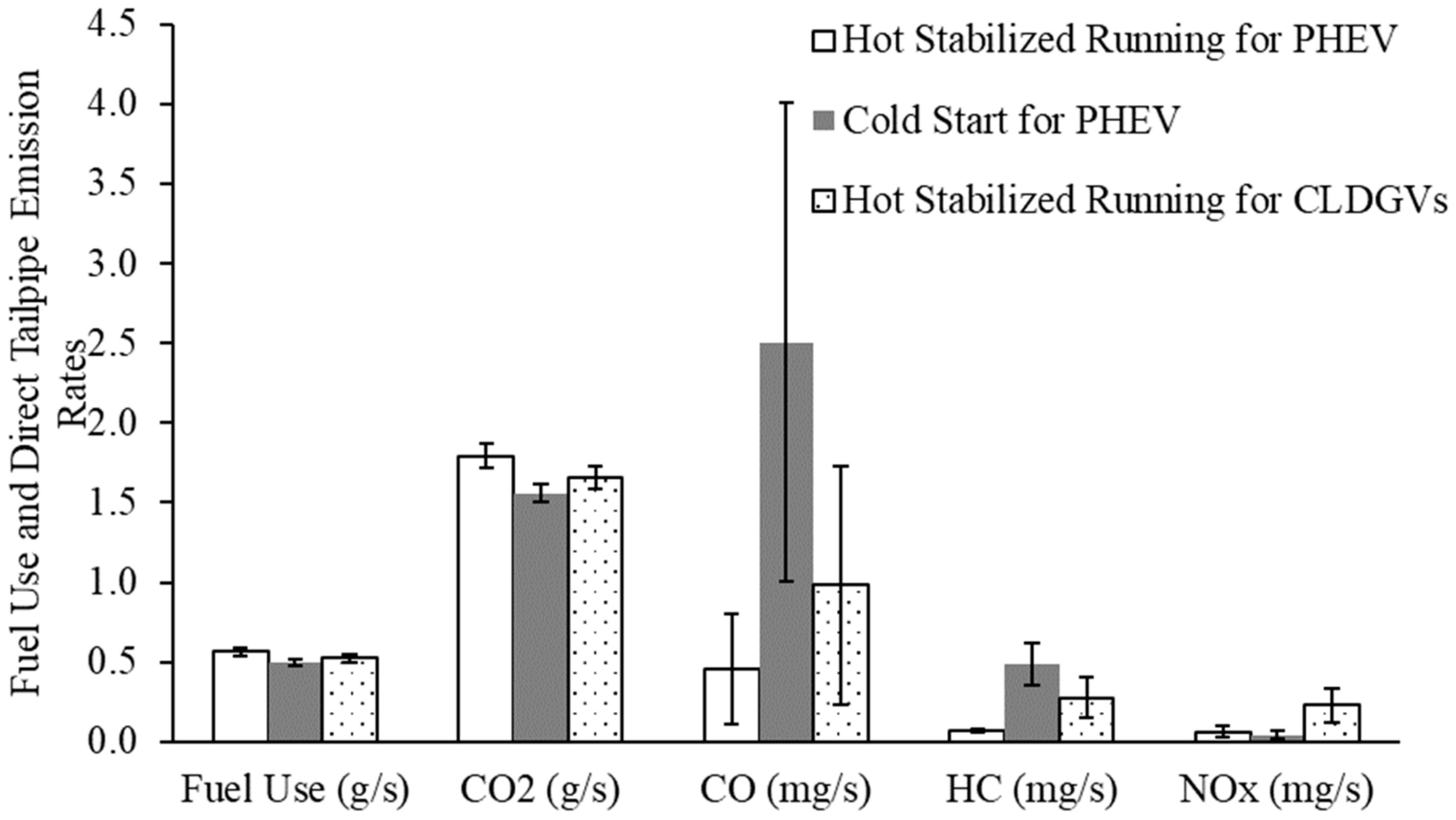
| Abbreviation | Definition | Abbreviation | Definition |
|---|---|---|---|
| AER | All Electric Range | MFF | Mass Fuel Flow |
| BEV | Battery Electric Vehicle | NDIR | Non-Dispersive Infrared |
| CD | Charge Depleting | NOx | Nitrogen Oxides |
| CLDGV | Conventional Light Duty Gasoline Vehicle | PHEV | Plug-in Hybrid Electric Vehicle |
| CO | Carbon Monoxide | PM10 | Particulate Matter less than 10 micro-meters in aerodynamic diameter |
| CS | Charge Sustaining | PM2.5 | Particulate Matter less than 2.5 micro-meters in aerodynamic diameter |
| CSEE | Cold Start Extra Emissions | RFG | Reformulated Gasoline |
| EIA | Energy Information Administration | RPM | Revolutions Per Minutee |
| ETV | Environmental Technology Verification | SAE | Society of Automotive Engineers |
| EU&E | Energy Use & Emissions | SOC | State of Charge |
| GPS | Global Position System | SOx | Sulfur Oxides |
| GREET | Greenhouse Gases, regulated Emissions, and Energy use in Transportation | TB | Traction Battery |
| HC | Hydrocarbons | Tcat | Catalyst Temperature |
| HEV | Hybrid Electric Vehicle | TEC | Engine Coolant Temperature |
| IAT | Intake Air Temperature | TWC | Three Way Catalyst |
| ICE | Internal Combustion Engine | VOC | Volatile Organic Compound |
| MAF | Mass Air Flow | VSP | Vehicle Specific Power |
| MAP | Manifold Absolute Pressure | VSS | Vehicle Speed |
| Mode | VSP Range (kW/ton) | Mode | VSP Range (kW/ton) | Mode | VSP Range (kW/ton) | |||
|---|---|---|---|---|---|---|---|---|
| Lower | Upper | Lower | Upper | Lower | Upper | |||
| 1 | −∞ | < −2 | 6 | ≥ 7 | < 10 | 11 | ≥ 23 | < 28 |
| 2 | ≥ −2 | < 0 | 7 | ≥ 10 | < 13 | 12 | ≥ 28 | < 33 |
| 3 | ≥ 0 | < 1 | 8 | ≥ 13 | < 16 | 13 | ≥ 33 | < 39 |
| 4 | ≥ 1 | < 4 | 9 | ≥ 16 | < 19 | 14 | ≥ 39 | +∞ |
| 5 | ≥ 4 | < 7 | 10 | ≥ 19 | < 23 | |||
| Vehicle Type | Mode | Statea | Main Energy Resource | Energy Use | CO2 | CO | HC | NOx | SOx | PM2.5 | PM10 |
|---|---|---|---|---|---|---|---|---|---|---|---|
| g/mile | mg/mile | ||||||||||
| PHEV | CDb | HI | Oil | 90.4 | 2.6× 102 | 2.9× 102 | 55 | 7.3 × 102 | 5.8 × 102 | 54 | 65 |
| WV | Coal | 84.4 | 3.0 × 102 | 1.1 × 102 | 51 | 2.4 × 102 | 3.3 × 102 | 35 | 62 | ||
| RI | Gas | 72.7 | 1.7 × 102 | 1.5 × 102 | 47 | 1.1 × 102 | 51 | 5.2 | 6.0 | ||
| VT | Nuclear | 87.2 | 47 | 1.1 × 102 | 28 | 45 | 22 | 2.6 | 3.6 | ||
| ID | Hydro | 80.6 | 54 | 77 | 28 | 36 | 23 | 2.5 | 3.4 | ||
| CSc | -- | -- | 69.0 | 2.0 × 102 | 78 | 71 | 1.2 × 102 | 92 | 8.0 | 11 | |
| CLDGVsd | -- | -- | -- | 1.27 × 102 | 3.7 × 102 | 4.2 × 102 | 1.7 × 102 | 2.6 × 102 | 1.7 × 102 | 15 | 21 |
© 2020 by the authors. Licensee MDPI, Basel, Switzerland. This article is an open access article distributed under the terms and conditions of the Creative Commons Attribution (CC BY) license (http://creativecommons.org/licenses/by/4.0/).
Share and Cite
Frey, H.C.; Zheng, X.; Hu, J. Variability in Measured Real-World Operational Energy Use and Emission Rates of a Plug-In Hybrid Electric Vehicle. Energies 2020, 13, 1140. https://doi.org/10.3390/en13051140
Frey HC, Zheng X, Hu J. Variability in Measured Real-World Operational Energy Use and Emission Rates of a Plug-In Hybrid Electric Vehicle. Energies. 2020; 13(5):1140. https://doi.org/10.3390/en13051140
Chicago/Turabian StyleFrey, H. Christopher, Xiaohui Zheng, and Jiangchuan Hu. 2020. "Variability in Measured Real-World Operational Energy Use and Emission Rates of a Plug-In Hybrid Electric Vehicle" Energies 13, no. 5: 1140. https://doi.org/10.3390/en13051140
APA StyleFrey, H. C., Zheng, X., & Hu, J. (2020). Variability in Measured Real-World Operational Energy Use and Emission Rates of a Plug-In Hybrid Electric Vehicle. Energies, 13(5), 1140. https://doi.org/10.3390/en13051140




